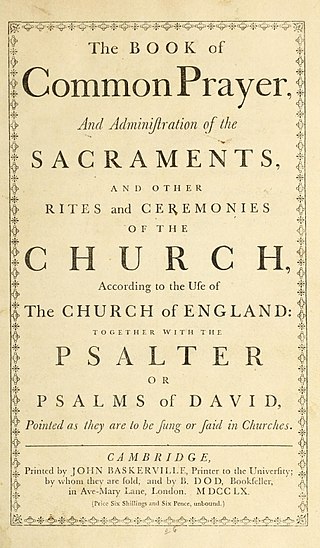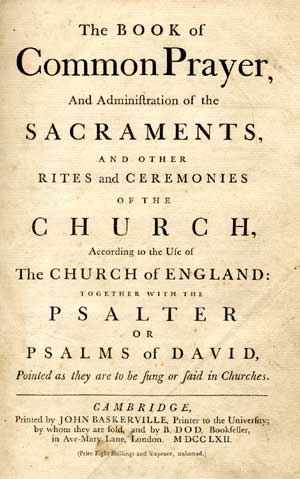
The Book of Common Prayer (BCP) is the name given to a number of related prayer books used in the Anglican Communion and by other Christian churches historically related to Anglicanism. The first prayer book, published in 1549 in the reign of King Edward VI of England, was a product of the English Reformation following the break with Rome. The 1549 work was the first prayer book to include the complete forms of service for daily and Sunday worship in English. It contains Morning Prayer, Evening Prayer, the Litany, Holy Communion, and occasional services in full: the orders for Baptism, Confirmation, Marriage, "prayers to be said with the sick", and a funeral service. It also sets out in full the "propers" : the introits, collects, and epistle and gospel readings for the Sunday service of Holy Communion. Old Testament and New Testament readings for daily prayer are specified in tabular format, as are the Psalms and canticles, mostly biblical, to be said or sung between the readings.

The Use of Sarum is the liturgical use of the Latin rites developed at Salisbury Cathedral and used from the late eleventh century until the English Reformation. It is largely identical to the Roman Rite, with about ten per cent of its material drawn from other sources. The cathedral's liturgy was widely respected during the late Middle Ages, and churches throughout the British Isles and parts of northwestern Europe adapted its customs for celebrations of the Eucharist and canonical hours. The Sarum Rite has a unique ecumenical position in influencing and being authorized for liturgical use by the Roman Catholic Church, Eastern Orthodox Church, as well as the Anglican Communion.
Christian liturgy is a pattern for worship used by a Christian congregation or denomination on a regular basis. The term liturgy comes from Greek and means "public work". Within Christianity, liturgies descending from the same region, denomination, or culture are described as ritual families.

A customary is a Christian liturgical book containing the adaptation of a ritual family and rite for a particular context, typically to local ecclesiastical customs and specific church buildings. A customary is generally synonymous to and sometimes constituent of a consuetudinary that contains the totality of the consuetudines—ceremonial forms and regulations—used in the services and community practices of a particular monastery, religious order, or cathedrals. The distinctive qualities of medieval liturgical uses are often described within customaries. In modern contexts, a customary may also be referred to as a custom book.

Walter Howard Frere was an English Anglican bishop and liturgist. He was a co-founder of the Anglican religious order the Community of the Resurrection, Mirfield, and Bishop of Truro (1923–1935).

The 1928 Book of Common Prayer, sometimes known as the Deposited Book, is a liturgical book which was proposed as a revised version of the Church of England's 1662 Book of Common Prayer. Opposing what they saw as an Anglo-Catholic revision that would align the Church of England with the Catholic Church—particularly through expanding the practice of the reserved sacrament—Protestant evangelicals and nonconformists in Parliament put up significant resistance, driving what became known as the Prayer Book Crisis.
A use, also commonly usage and recension, within Christian liturgy is a set of particular texts or customs distinct from other practitioners of a broader liturgical ritual family, typically on the basis of locality or religious order. Especially prevalent within the Latin liturgical rites of the Middle Ages, few significant uses persisted following a general suppression of these variations by Pope Pius V in the 16th century. The word "use" is most commonly applied to distinct practices branching from the Roman Rite, though it and "recension" can be applied in variations of other ritual families, such as the to Ruthenian recension of the Byzantine Rite and Maronite Use of the West Syriac Rite. In the historic context of the Scottish Episcopal Church, "usage" refers to certain aspects of the Eucharistic liturgy valued by some nonjurors.

The 1979 Book of Common Prayer is the official primary liturgical book of the U.S.-based Episcopal Church. An edition in the same tradition as other versions of the Book of Common Prayer used by the churches within the Anglican Communion and Anglicanism generally, it contains both the forms of the Eucharistic liturgy and the Daily Office, as well as additional public liturgies and personal devotions. It is the fourth major revision of the Book of Common Prayer adopted by the Episcopal Church, and succeeded the 1928 edition. The 1979 Book of Common Prayer has been translated into multiple languages and is considered a representative production of the 20th-century Liturgical Movement.

The 1962 Book of Common Prayer is an authorized liturgical book of the Canada-based Anglican Church of Canada. The 1962 prayer book is often also considered the 1959 prayer book, in reference to the year the revision was first approved for an "indefinite period" of use beginning in 1960. The 1962 edition follows from the same tradition of other versions of the Book of Common Prayer used by the churches within the Anglican Communion and Anglicanism generally. It contains both the Eucharistic liturgy and Daily Office, as well as additional public liturgies and personal devotions. The second major revision of the Book of Common Prayer of the Anglican Church of Canada, the 1962 Book of Common Prayer succeeded the 1918 edition, which itself had replaced the Church of England's 1662 prayer book. While supplanted by the 1985 Book of Alternative Services as the Anglican Church of Canada's primary Sunday service book, the 1962 prayer book continues to see usage.

The 1662 Book of Common Prayer is an authorised liturgical book of the Church of England and other Anglican bodies around the world. In continuous print and regular use for over 360 years, the 1662 prayer book is the basis for numerous other editions of the Book of Common Prayer and other liturgical texts. Noted for both its devotional and literary quality, the 1662 prayer book has influenced the English language, with its use alongside the King James Version of the Bible contributing to an increase in literacy from the 16th to the 20th century.

The 1604 Book of Common Prayer, often called the Jacobean prayer book or the Hampton Court Book, is the fourth version of the Book of Common Prayer as used by the Church of England. It was introduced during the early English reign of James I as a product of the Hampton Court Conference, a summit between episcopalian, Puritan, and Presbyterian factions. A modest revision of the 1559 prayer book, the Jacobean prayer book became the basis of the 1662 Book of Common Prayer, a still-authorized liturgical book within the Church of England and global Anglicanism.
An ordinal, in a modern context, is a liturgical book that contains the rites and prayers for the ordination and consecration to the Holy Orders of deacons, priests, and bishops in multiple Christian denominations, especially the Edwardine Ordinals within Anglicanism. The term "ordinal" has been applied to the prayers and ceremonies for ordinations in the Catholic Church, where the pontificals of the Latin liturgical rites typically compile them along with other liturgies exclusive to bishops. In medieval liturgies, ordinals supplied instruction on how to use the various books necessary to celebrate a liturgy and added rubrical direction.

The Edwardine Ordinals are two ordinals primarily written by Thomas Cranmer as influenced by Martin Bucer and first published under Edward VI, the first in 1550 and the second in 1552, for the Church of England. Both liturgical books were intended to replace the ordination liturgies contained within medieval pontificals in use before the English Reformation.

Since the 18th century, there have been several editions of the Book of Common Prayer produced and revised for use by Unitarians. Several versions descend from an unpublished manuscript of alterations to the Church of England's 1662 Book of Common Prayer originally produced by English philosopher and clergyman Samuel Clarke in 1724, with descendant liturgical books remaining in use today.

The 1559 Book of Common Prayer, also called the Elizabethan prayer book, is the third edition of the Book of Common Prayer and the text that served as an official liturgical book of the Church of England throughout the Elizabethan era.

The 1637 Book of Common Prayer, commonly known as the Scottish Prayer Book or Scottish liturgy, was a version of the English Book of Common Prayer revised for use by the Church of Scotland. The 1637 prayer book shared much with the 1549 English prayer book—rather than the later, more reformed English revisions—and contained Laudian liturgical preferences with some concessions to a Scottish and Presbyterian audience. Charles I, as King of Scotland and England had wished to impose the liturgical book to align Scottish worship with that of the Church of England. However, after a coordinated series of protests—including the legendary opposition by Jenny Geddes at St Giles' Cathedral—the 1637 prayer book was rejected.

The Oxford Guide to the Book of Common Prayer: A Worldwide Survey is a nonfiction reference work edited by Charles Hefling and Cynthia Shattuck which was published by Oxford University Press in 2006. The volume covered the development of the Book of Common Prayer as the dominant liturgical book of Anglicanism from the prayer book's origins in 16th-century England through to its global use and influence in the modern era, including coverage of the prayer book's influence on non-Anglican Christians. It was composed by 58 authors and was divided into more than 70 essays.

Free and Candid Disquisitions is a 1749 pamphlet written and compiled by John Jones, a Welsh Church of England clergyman, and published anonymously. The work promoted a series of specific reforms to both the Church of England and its mandated book for liturgical worship, the 1662 Book of Common Prayer. Through these proposed changes, Jones hoped that the more Protestant independent Dissenters – who had largely broken with the Church of England in 1662 and been legally tolerated since 1689 – could be reintegrated into the church.

Geoffrey John Cuming was a Church of England clergyman, liturgist, and music historian. After being permanently injured during his British Army service prior to the Battle of Arnhem, Cuming was ordained a priest. He authored and edited several nonfiction texts on music and Christianity.
Francis Procter was an English Anglican clergyman and liturgist known for his history of the Book of Common Prayer, the official liturgical book of the Church of England. His A History of the Book of Common Prayer, with a Rationale of its Offices was first published in 1855. A revision of this book first released in 1901 by Walter Frere–known as "Procter and Frere"–became a leading academic history of Anglican liturgy. Procter also produced other works, including an edition of the Sarum breviary first published in 1875. During his career, Procter was a fellow at St Catharine's College, Cambridge, and a minister at several English parishes.
















